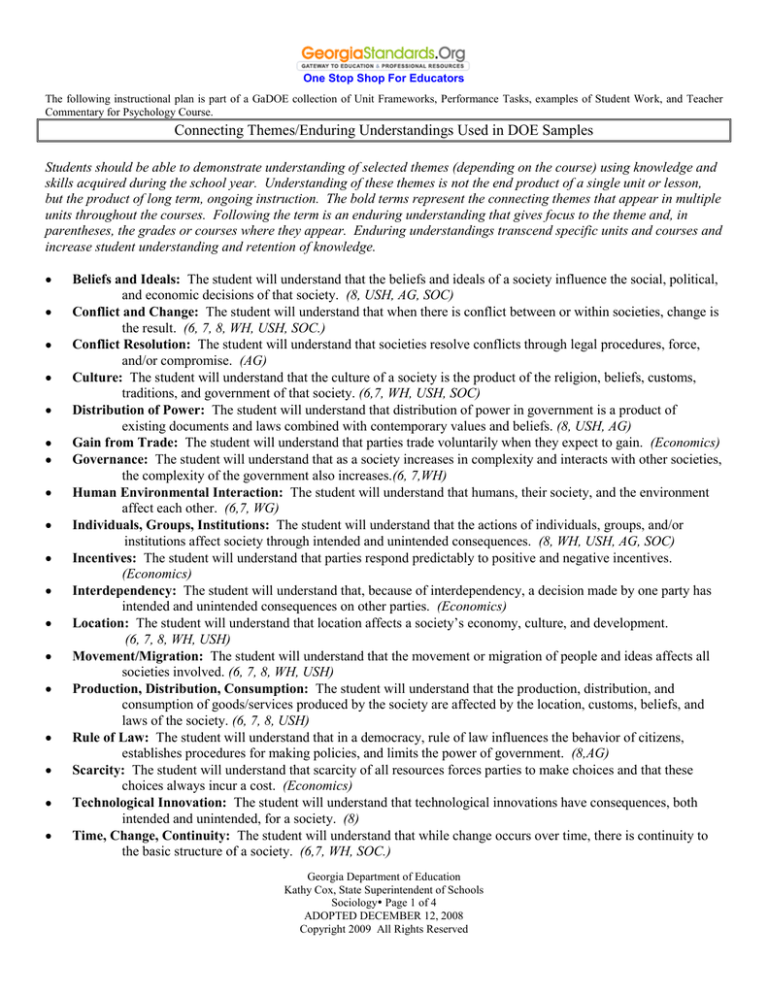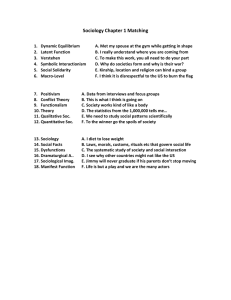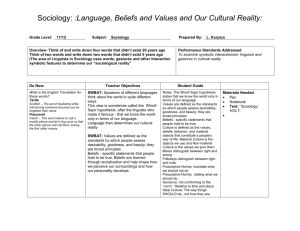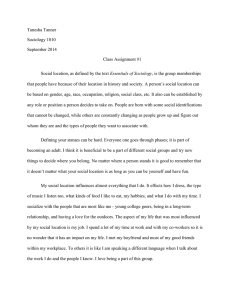
One Stop Shop For Educators
The following instructional plan is part of a GaDOE collection of Unit Frameworks, Performance Tasks, examples of Student Work, and Teacher
Commentary for Psychology Course.
Connecting Themes/Enduring Understandings Used in DOE Samples
Students should be able to demonstrate understanding of selected themes (depending on the course) using knowledge and
skills acquired during the school year. Understanding of these themes is not the end product of a single unit or lesson,
but the product of long term, ongoing instruction. The bold terms represent the connecting themes that appear in multiple
units throughout the courses. Following the term is an enduring understanding that gives focus to the theme and, in
parentheses, the grades or courses where they appear. Enduring understandings transcend specific units and courses and
increase student understanding and retention of knowledge.
Beliefs and Ideals: The student will understand that the beliefs and ideals of a society influence the social, political,
and economic decisions of that society. (8, USH, AG, SOC)
Conflict and Change: The student will understand that when there is conflict between or within societies, change is
the result. (6, 7, 8, WH, USH, SOC.)
Conflict Resolution: The student will understand that societies resolve conflicts through legal procedures, force,
and/or compromise. (AG)
Culture: The student will understand that the culture of a society is the product of the religion, beliefs, customs,
traditions, and government of that society. (6,7, WH, USH, SOC)
Distribution of Power: The student will understand that distribution of power in government is a product of
existing documents and laws combined with contemporary values and beliefs. (8, USH, AG)
Gain from Trade: The student will understand that parties trade voluntarily when they expect to gain. (Economics)
Governance: The student will understand that as a society increases in complexity and interacts with other societies,
the complexity of the government also increases.(6, 7,WH)
Human Environmental Interaction: The student will understand that humans, their society, and the environment
affect each other. (6,7, WG)
Individuals, Groups, Institutions: The student will understand that the actions of individuals, groups, and/or
institutions affect society through intended and unintended consequences. (8, WH, USH, AG, SOC)
Incentives: The student will understand that parties respond predictably to positive and negative incentives.
(Economics)
Interdependency: The student will understand that, because of interdependency, a decision made by one party has
intended and unintended consequences on other parties. (Economics)
Location: The student will understand that location affects a society’s economy, culture, and development.
(6, 7, 8, WH, USH)
Movement/Migration: The student will understand that the movement or migration of people and ideas affects all
societies involved. (6, 7, 8, WH, USH)
Production, Distribution, Consumption: The student will understand that the production, distribution, and
consumption of goods/services produced by the society are affected by the location, customs, beliefs, and
laws of the society. (6, 7, 8, USH)
Rule of Law: The student will understand that in a democracy, rule of law influences the behavior of citizens,
establishes procedures for making policies, and limits the power of government. (8,AG)
Scarcity: The student will understand that scarcity of all resources forces parties to make choices and that these
choices always incur a cost. (Economics)
Technological Innovation: The student will understand that technological innovations have consequences, both
intended and unintended, for a society. (8)
Time, Change, Continuity: The student will understand that while change occurs over time, there is continuity to
the basic structure of a society. (6,7, WH, SOC.)
Georgia Department of Education
Kathy Cox, State Superintendent of Schools
Sociology Page 1 of 4
ADOPTED DECEMBER 12, 2008
Copyright 2009 All Rights Reserved
One Stop Shop For Educators
The following instructional plan is part of a GaDOE collection of Unit Frameworks, Performance Tasks, examples of Student Work, and Teacher Commentary for Psychology
Course.
Sociology
Standards: The focus of this important
first unit is on the concepts and
enduring understandings rather than
specific standards.
Standards:
SSSoc.FR1
Standards:
SSSoc.FR2, SSSoc.FR3
Standards:
SSSoc.C1, SSSoc.C2, SSSoc.C3
Unit One focus:
Unit two focus:
Unit three focus:
Unit four focus:
Introduction to Thematic
Connections in Sociology
Introduction to the
Foundations of Sociology
Using Sociology,
understanding theories
and doing research
Culture and Social
Structure
INDIVIDUALS, GROUPS, AND
INSTITUTIONS
Origins and founders (FR1b)
Relationship with other social
sciences (FR1c)
Applying sociology in everyday
life and in careers (FR1d)
BELIEFS & IDEALS
Understanding the basis of the
three major theories (FR3a,
FR3b)
Ethics in sociology (FR2d)
Conducting research in
Sociology. (FR2b)
BELIEFS AND IDEALS
Sociological perspective.
(FR1a)
Sociological imagination
(FR1a)
CONFLICT AND CHANGE
Similarities and differences in
the three major theories and
applications (FR3a, FR3b)
INDIVIDUALS,
GROUPS, AND
INSTITUTIONS
CONFLICT &
CHANGE
CULTURE
BELIEFS AND
IDEALS
TIME, CHANGE,
AND CONTINUITY
TIME, CHANGE, AND
CONTINUITY
Understanding the history of
Sociology. (FR1b)
INDIVIDUALS, GROUPS, AND
INSTITUTIONS
Application of the major
research methods used to study
group behavior in sociology
(FR2a, FR2b, FR2c)
Georgia Department of Education
Kathy Cox, State Superintendent of Schools
Sociology Page 2 of 4
ADOPTED DECEMBER 12, 2008
Copyright 2009 All Rights Reserved
CULTURE, BELIEFS, AND
IDEALS
Culture as a social construction
(C1a)
Basic characteristics of a
culture (C1b)
Structure and interactions
within societies.(C3a,b,c,d)
CONFLICT & CHANGE
Cultural change and diversity
(C2a)
INDIVIDUALS, GROUPS, &
INSTITUTIONS
Importance of culture in the
organization of society. (C1c)
Material vs. non material
culture (C2b)
TIME, CHANGE, CONTINUITY
Static and dynamic components
of culture (Pop culture vs.
values that remain constant
(C1d and C2a)
Impact of globalization on
world cultures (C2c)
One Stop Shop For Educators
The following instructional plan is part of a GaDOE collection of Unit Frameworks, Performance Tasks, examples of Student Work, and Teacher Commentary for Psychology
Course.
Sociology
Standards: SSSocC1, SSSoc.C2,
SSSoc.C3
Standards: SSSocSC1
Standards: SSSoc.SC2, SSSoc.SC3,
SSSoc.SC4
Standards: SSSocIC1
Unit Five focus:
Unit Six focus:
Unit Seven focus:
Unit Eight focus:
Social Structure
Socialization within the
group.
Social Control
Social Inequality
INDIVIDUALS, GROUPS, &
INSTITUTIONS
Components of social structure
including status, role, and social
institutions (C3a)
Groups within a society
(primary, secondary, in and out
groups, reference, and social
networks) (C3c)
Components, varieties, and
functions of group dynamic
(C3d)
Formal organizations and
bureaucracies (C3e)
Development and importance of
culture. (C1 a,b,c,d)
CULTURE
Types of societies (C3b)
How cultures develop (C2a c)
BELIEFS & IDEALS
Importance of culture(C1c, d)
Components of culture (C1d)
BELIEFS & IDEALS
Factors that socialize the
individual (family, peers,
education, media, and religion
(SC1c,d,e)
TIME, CHANGE, AND
CONTINUITY
Theories of social development
over time, including those of
Cooley, Locke, and Mead
(SC1b)
Stages of socialization and the
role of the individual. (SC1a,c)
INDIVIDUALS, GROUPS, &
INSTITUTIONS
The role and responsibility of
the individual in society (SC1a)
Socialization by gender and
race/ethnicity. (SC1e)
Effect of the peer group on
individual socialization (SC1d)
BELIEFS & IDEALS
Causes of deviant behavior (SC2c)
Relationship between conformity,
deviance, and social control. (SC3b)
CONFLICT & CHANGE
Socially constructed nature of
deviance (SC2a)
Social control and power in society
(SC2b)
Theories of social control (SC3a)
Functions and inequalities of the
criminal justice system (SC4d)
INDIVIDUALS, GROUPS, &
INSTITUTIONS
Impact of adaptation, cooperation,
accommodation, and competition on
social control (SC3c)
Role of the total institution (SC4e)
TIME, CHANGE, AND
CONTINUITY
Function of social institutions
(SC4a, b, c,)
Process of re-socializing the
individual (SC4f)
Impact of deviance on society (SC2d)
Georgia Department of Education
Kathy Cox, State Superintendent of Schools
Sociology Page 3 of 4
ADOPTED DECEMBER 12, 2008
Copyright 2009 All Rights Reserved
BELIEFS & IDEALS
Sources of social stratification
(IC1b)
Sources of global stratification
(IC1c)
CONFLICT & CHANGE
Unequal distribution of power
and (IC1a)
Unequal distribution of
resources (IC1a)
Effects of social stratification
based on social class, race,
ethnicity, gender, age, and
emotional, mental, and physical
disability. (IC1b)
CULTURE
Impact of global inequality on
global cultures and relations
(IC1d)
Impact of stratification (IC1d)
TIME, CHANGE, AND
CONTINUITY
Sources of global stratification
and inequality (IC1c)
One Stop Shop For Educators
The following instructional plan is part of a GaDOE collection of Unit Frameworks, Performance Tasks, examples of Student Work, and Teacher Commentary for Psychology
Course.
Sociology
Standards: SSSoc.IC2
Unit Nine focus:
Collective Behavior and
Social Change
CONFLICT & CHANGE
Impact of technology on social
change (IC1c)
The process of social change in a
society (IC2b)
INDIVIDUALS, GROUPS, &
INSTITUTIONS
Forms of collective behavior
(Riot, Mob, Revolution, Acting
Crowd, Fads, etc) (IC2a)
TIME, CHANGE, AND
CONTINUITY
Impact of globalization on
social change (IC1b)
Impact of demographic changes
and settlement pattern change
on a society (IC1c)
Social change process in a
society. (IC2b,c,d)
Georgia Department of Education
Kathy Cox, State Superintendent of Schools
Sociology Page 4 of 4
ADOPTED DECEMBER 12, 2008
Copyright 2009 All Rights Reserved







